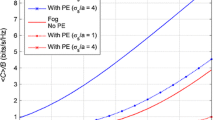Abstract
The influence of the degree of transmitting beam coherence on the bit error rate in free-space optical communication systems is studied. It is found that there are optimal values of the output power and degree of coherence of a transmitter optical beam, defined by the Fried radius, for all types of propagation paths (horizontal, vertical, or inclined) and different degrees of manifestation of turbulent effects. The optimal degree of coherence can be determined from the calculated BER minimum.
Similar content being viewed by others
References
L. C. Andrews, R. L. Phillips, and C. Y. Hopen, Laser Beam Scintillation with Applications (SPIE Press, Bellingham; Washington, DC, 2001).
A. K. Majumdar, “Free-Space Laser Communication Performance in the Atmospheric Channel,” J. Opt. Fiber. Commun. Rep. 2(4), 345–396 (2005).
D. L. Fried, “Aperture Averaging of Scintillation,” J. Opt. Soc. Amer. 57(2), 169–175 (1967).
J. C. Ricklin and F. M. Davidson, “Atmospheric Optical Communication with a Gaussian Schell Beam,” J. Opt. Soc. Amer., A 20(5), 856–866 (2003).
O. Korotkova, L. C. Andrews, and R. L. Phillips, “Model for a Partially Coherent Gaussian Beam in Atmospheric Turbulence with Application in Lasercom,” Opt. Eng. 43(2), 330–341 (2004).
J. C. Ricklin, S. M. Hammel, F. D. Eaton, and S. L. Lachinova, “Atmospheric Channel Effects on Free-Space Laser Communication,” J. Opt. Fiber. Commun. Rep. 3(2), 111–158 (2006).
P. Polynkin, A. Peleg, L. Klein, T. Rhoadarmer, and J. Moloney, “Optimized Multiemitter Beams for Free-Space Optical Communications through Turbulent Atmosphere,” Opt. Lett. 32(8), 885–887 (2007).
D. G. Voelz and X. Xiao, “A Brief Review of Spatially Partially Coherent Beams for FSO Communications,” Proc. SPIE. 7200, 72000 (2009).
X. Xiao and D. G. Voelz, “On-Axis Probability Density Function and Fade Behavior of Partially Coherent Beams Propagating Through Turbulence,” Appl. Opt. 48(2), 167–175 (2009).
D. G. Voelz and X. Xiao, “Metric for Optimizing Spatially Partially Coherent Beams for Propagation through Turbulence,” Opt. Eng. 48(3), 036001 (2009).
C. Chen, H. Yang, X. Feng, and H. Wang, “Optimization Criterion for Initial Coherence Degree of Lasers in Free-Space Optical Links through Atmospheric Turbulence,” Opt. Lett. 34(4), 419–421 (2009).
D. K. Borah and D. G. Voelz, “Spatially Partially Coherent Beam Parameter Optimization for Free Space Optical Communications,” Opt. Exp. 18(20) (2010).
M. A. Al-Habash, L. C. Andrews, and R. L. Phillips, “Mathematical Model for the Irradiance Probability Density Function of a Laser Beam Propagating through Turbulent Media,” Opt. Eng. 40(8), 1554–1562 (2001).
B. Sklyar, Digital Communications. Theoretical Grounds and Practical Applications (Izdatel’skii dom “Vil’yams”, Moscow, 2007) [in Russian].
J. Proakis, Digital Communications (McGraw-Hill, New York, 1995), 3rd ed.
R. K. Tyson, “Bit-Error Rate for Free-Space Adaptive Optics Laser Communications,” J. Opt. Soc. Amer., A 19(4), 753–758 (2002).
S. M. Flatte, C. Bracher, and G.-Y. Wang, “Probability Density Functions of Irradiance for Waves in Atmospheric Turbulence Calculated by Numerical Simulation,” J. Opt. Soc. Amer., A 11(7), 2080–2092 (1994).
J. H. Churnside and R. J. Hill, “Probability Density of Irradiance Scintillations for Strong Path-Integrated Refractive Turbulence,” J. Opt. Soc. Amer., A 4(4), 727–733 (1987).
R. J. Hill and R. G. Frehlich, “Probability Distribution of Irradiance for the Onset of Strong Scintillation,” J. Opt. Soc. Amer., A 14(7), 1530–1540 (1997).
L. C. Andrews, R. L. Phillips, and C. Y. Hopen, Laser Beam Scintillation with Applications (SPIE Press, Bellingham; Washington, DC, 2001).
M. Nakagami, The M Distribution—a General Formula of Intensity Distribution of Rapid Fading, Statistical Methods in Radio Wave Propagation, Ed. by W. C. Hoffman (Pergamon, New York, 1960).
R. V. Hogg and A. T. Craig, Introduction to Mathematical Statistics (Macmillan, New York, 1978).
M. H. Mahdieh and M. Pournoury, “Atmospheric Turbulence and Numerical Evaluation of Bit Error Rate (BER) in Free-Space Communication,” Opt. & Laser Technol. 42(1), 55–60 (2010).
V. V. Kolosov and A. V. Kuzikovskii, “Phase Compensation of Refraction Distortions of Partly Coherent Beams,” Kvant. Elektron. 8(3), 490–494 (1981).
M. A. Vorontsov and V. V. Kolosov, “Target-in-the-Loop Beam Control: Basic Considerations for Analysis and Wavefront Sensing,” J. Opt. Soc. Amer., A 22(1), 126–141 (2005).
P. A. Konyaev, E. A. Tartakovskii, and G. A. Filimonov, “Computer Simulation of Optical Wave Propagation with the Use of Parallel Programming,” Atmos. Ocean. Opt. 24(5), 425–431 (2011).
V. A. Banakh, I. N. Smalikho, and A. V. Falits, “Effectiveness of the Subharmonic Method in Problems of Computer Simulation of Laser Beam Propagation in a Turbulent Atmosphere,” Atmos. Ocean. Opt. 25(2), 106–109 (2012).
D. A. Marakasov and D. S. Rychkov, “Method for Calculating Moments of the Wigner Distribution Function of Laser Beams in a Turbulent Atmosphere,” Atmos. Ocean. Opt. 25(2), 127–129 (2012).
A. S. Gurvich, A. I. Kon, V. L. Mironov, and S. S. Khmelevtsov, Laser Radiation in Turbulent Atmosphere (Nauka, Moscow, 1976) [in Russian].
V. E. Zuev, V. A. Banakh, and V. V. Pokasov, Modern Problems of Atmospheric Optics. Optics of Turbulent Atmosphere, Ed. by V. E. Zuev (Gidrometeoizdat, Leningrad, 1988) [in Russian].
Author information
Authors and Affiliations
Additional information
Original Russian Text © M.A. Vorontsov, V.V. Dudorov, M.O. Zyryanova, V.V. Kolosov, G.A. Filimonov, 2013, published in Optica Atmosfery i Okeana.
Rights and permissions
About this article
Cite this article
Vorontsov, M.A., Dudorov, V.V., Zyryanova, M.O. et al. Bit error rate in free-space optical communication systems with a partially coherent transmitting beam. Atmos Ocean Opt 26, 185–189 (2013). https://doi.org/10.1134/S1024856013030159
Received:
Published:
Issue Date:
DOI: https://doi.org/10.1134/S1024856013030159




